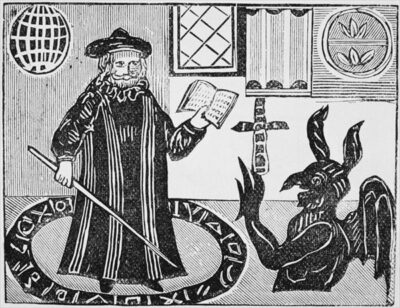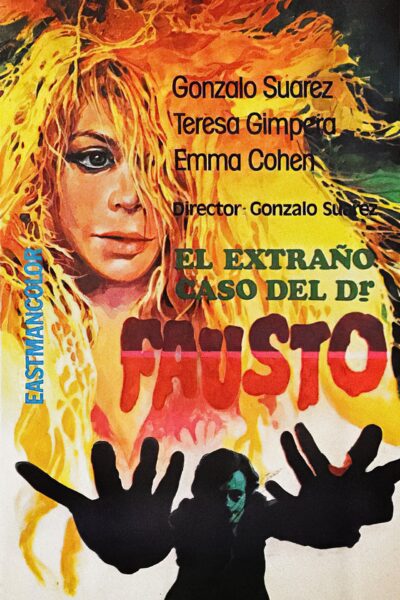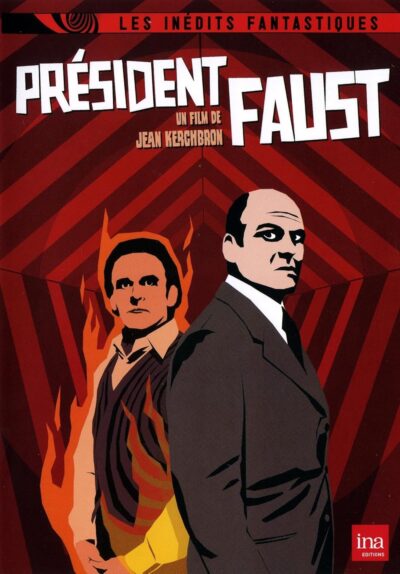 The Faust legend reconfigured as avant-garde science fiction? It’s an approach that, in European hands, works far better than you might expect, as proven by the Spanish feature THE STRANGE CASE OF DR. FAUSTO (El extraño caso del doctor Fausto; 1969) and the French telefilm PRESIDENT FAUST (1974).
The Faust legend reconfigured as avant-garde science fiction? It’s an approach that, in European hands, works far better than you might expect, as proven by the Spanish feature THE STRANGE CASE OF DR. FAUSTO (El extraño caso del doctor Fausto; 1969) and the French telefilm PRESIDENT FAUST (1974).
The legend of Faust, hailing from Germany (and based on the medieval alchemist Johann Georg Faust), involves a dissatisfied man making a deal with the devil for wealth and power in exchange for his mortal soul, which, he quickly discovers, is not the worthwhile bargain it initially seemed. The tale has been the subject of more fictional treatments than I can count, with the most iconic being THE TRAGICAL HISTORY OF THE LIFE AND DEATH OF DR. FAUSTUS (1592) by Christopher Marlowe and the German drama FAUST (1808) by Johann Wolfgang von Goethe. Among the subsequent treatments informed by this pair are F.W. Murnau’s 1926 film FAUST, Thomas Mann’s 1947 novel DOKTOR FAUSTUS, Jan Svankmajer’s 1994 and Alexander Sokurov’s 2011 filmings, and the films under discussion, which offer two of the most radical and unorthodox interpretations.
 THE STRANGE CASE OF DR. FAUSTO is indeed strange. It’s said, in fact, to be the strangest film ever made by Spain’s Gonzalo Suárez, a bold claim given that Suárez’s films, which include the likes of AOOM (1970) and DON JUAN IN HELL (1991), tend to be extremely odd in general.
THE STRANGE CASE OF DR. FAUSTO is indeed strange. It’s said, in fact, to be the strangest film ever made by Spain’s Gonzalo Suárez, a bold claim given that Suárez’s films, which include the likes of AOOM (1970) and DON JUAN IN HELL (1991), tend to be extremely odd in general.
The film is a (very) free updating of the Faust legend, told largely from the point of view of Hell’s messenger Mephistopheles. This figure, played by Suárez, is portrayed as a vacant-eyed freak who narrates the proceedings in a room filled with snazzy machinery. He is, it seems, an emissary of some alien race, sent to Earth to tempt Dr. Fausto (Alberto Puig), a wealthy scholar. The only problem is that this Mephisto has to vacate the planet as soon as the mission is complete or risk being stuck in human form forever.
The alien theme explains in part why the film, visualized entirely through fish eyed lenses and consistently odd angles, is so bizarre. What didn’t quite compute is a kid’s drawing ceremonially burned over an open flame that takes up much of the film’s opening third, as well as a lengthy bit in which Faust’s young son ecstatically jumps up and down in his crib and the camera follows suit, and the elaborate interpretive dances that substitute for behavior and dialogue. The film looks quite good, at least, proving that even at his most self-indulgent Gonzalo Suárez has a real talent for evocative imagery.
PRESIDENT FAUST arrived 5 years later. A product of French television, which turned out some amazing late 20th Century telefilms (such as MONSIEUR ROBERT HOUDIN and L’INVENTION DE MOREL), it was directed by the Gallic TV veteran Jean Kerchbron (1924-2003) and co-scripted by Louis Pauwels (1920-1997). The film they turned out is a demanding one that delves quite deeply into the legend’s political and philosophical underpinnings.
The setting is a near-future France whose residents include the uber-wealthy oil magnate Henri Faust (François Chaumette), who according to one estimate “belongs to humanity the way a splinter wedged under a fingernail belongs to a finger.” He stays fit, wields unlimited power and has no problem getting old, and so presents the devil with quite a challenge when he turns up in the form of “Mister” (François Simon) to offer the familiar bargain. Faust turns down the offer with the question “Sell one’s soul…what soul?”
Mister proves quite persistent, staying on as a business advisor. As such Mister dabbles quite extensively in Faust’s activities and relationships with his rebellious son Axel (Olivier Sidney) and mistress Marguerite (France Dougnac). It’s the latter who provokes Faust’s downfall, as it’s she who inspires him to finally make the bargain so desired by Mister, asking not for material gain but increased humanity so he can deepen his relationship with Marguerite. Mister complies with the terms, which seals his own fate in addition to that of Faust, as in his newly humanized form he acts in a more compassionate, and so less devil-friendly, manner.
rebellious son Axel (Olivier Sidney) and mistress Marguerite (France Dougnac). It’s the latter who provokes Faust’s downfall, as it’s she who inspires him to finally make the bargain so desired by Mister, asking not for material gain but increased humanity so he can deepen his relationship with Marguerite. Mister complies with the terms, which seals his own fate in addition to that of Faust, as in his newly humanized form he acts in a more compassionate, and so less devil-friendly, manner.
The connection between PRESIDENT FAUST and the acid trip strangeness of the former film might initially seem nonexistent, but be advised that Jean Kerchbron’s film grows steadily weirder as it advances. The visuals become increasingly stylized, as does the freeform staging that utilizes rear projection, prismed reflections and much fourth wall breaking that allows for Mister to directly address the viewer. The bizarre set decoration, particularly a chair in Faust’s office with a ceramic hand at its top that hovers over the head of the person sitting in it, further enhances the surreality.
This being a TV movie, the distractingly low budget production values are to be expected, but the stylish mise-en-scene goes a long way toward compensating, as do the performances of François Chaumette as Faust and the lip-smackingly sinister François Simon as Mister. This is, again, not an especially easy watch, but it does offer an unforgettable twisting of one of the world’s most familiar tales.
